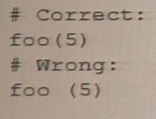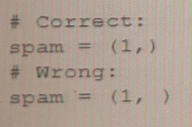At ValidExamDumps, we consistently monitor updates to the Python Institute PCPP-32-101 exam questions by Python Institute. Whenever our team identifies changes in the exam questions,exam objectives, exam focus areas or in exam requirements, We immediately update our exam questions for both PDF and online practice exams. This commitment ensures our customers always have access to the most current and accurate questions. By preparing with these actual questions, our customers can successfully pass the Python Institute PCPP1 - Certified Professional in Python Programming 1 exam on their first attempt without needing additional materials or study guides.
Other certification materials providers often include outdated or removed questions by Python Institute in their Python Institute PCPP-32-101 exam. These outdated questions lead to customers failing their Python Institute PCPP1 - Certified Professional in Python Programming 1 exam. In contrast, we ensure our questions bank includes only precise and up-to-date questions, guaranteeing their presence in your actual exam. Our main priority is your success in the Python Institute PCPP-32-101 exam, not profiting from selling obsolete exam questions in PDF or Online Practice Test.
Which function or operator should you use to obtain the answer True or False to the question: "Do two variables refer to the same object?"
To test whether two variables refer to the same object in memory, you should use theisoperator. Theisoperator returnsTrueif the two variables point to the same object in memory, andFalseotherwise.
For example:
a = [1, 2, 3]
b = a
c = [1, 2, 3]
print(a is b) # True
print(a is c) # False
In this example,aandbrefer to the same list object in memory, soa is breturnsTrue. On the other hand,aandcrefer to two separate list objects with the same values, soa is creturnsFalse.
Theisoperator is used to test whether two variables refer to the same object in memory. If two variablesxandyrefer to the same object, the expressionx is ywill evaluate toTrue. Otherwise, it will evaluate toFalse.
Look at the following code snippets and decide which ones follow PEP 8 recommendations for whitespaces in expressions and statements (Select two answers.)
A)
No whitespace immediately before the opening parenthesis that starts the list of arguments of a function call:

B)
A whitespace immediately before a comma, semicolon, and colon:

C)
No whitespace between a trailing comma and a following closing parenthesis:

D)
A whitespace immediately after the opening parenthesis that starts indexing or slicing:

Select the true statements related to PEP 8 naming conventions. (Select two answers.)
Option A is true because PEP 8 recommends that function and variable names should be lowercase, with words separated by underscores .
Option D is true because PEP 8 recommends that constants should be written in all capital letters with words separated by underscores .
PEP 8 is the official style guide for Python code. It provides guidelines for how to write readable code that follows consistent naming conventions. The aim of PEP 8 is to improve the readability of Python code and make it easier to understand and maintain.
According to PEP 8, variable and function names should be written in all lower-case letters with words separated by underscores, as stated in A. Constants, which are variables whose value is expected to remain constant throughout the code, should be written in all upper-case letters with words separated by underscores, as stated in D.
PEP 8 -- Style Guide for Python Code:https://www.python.org/dev/peps/pep-0008/
Python Documentation:https://docs.python.org/3/tutorial/classes.html#classmethods-and-staticmethods
What will happen if the mam window is too small to fit all its widgets?
If the main window is too small to fit all its widgets,some widgets may be invisible. So, the correct answer isOption A.
When a window is not large enough to display all of its content, some widgets may be partially or completely hidden. The window will not automatically expand to fit all of its content, and no exception will be raised. The widgets will not be automatically scaled down to fit the window's size.
If the main window is too small to fit all its widgets, some of the widgets may not be visible or may be partially visible. This is because the main window has a fixed size, and if there are more widgets than can fit within that size, some of them will be outside the visible area of the window.
To avoid this issue, you can use layout managers such asgrid,pack, orplaceto dynamically adjust the size and position of the widgets as the window changes size. This will ensure that all the widgets remain visible and properly arranged regardless of the size of the main window.
https://www.tkdocs.com/tutorial/widgets.html#managers
https://www.geeksforgeeks.org/python-tkinter-widgets/
https://anzeljg.github.io/rin2/book2/2405/docs/tkinter/introduction.html
Which of the following will set the button text's font to 12 point italics Anal? (Select two answers)
A)

B)

C)

D)

Option B is correct because it sets the font option of the button to a tuple containing the font family ('Arial'), size (12), and style ('italic').
Option C is correct because it sets the font option of the button to a string containing the font family ('Arial'), size (12), and style ('italic') separated by spaces.